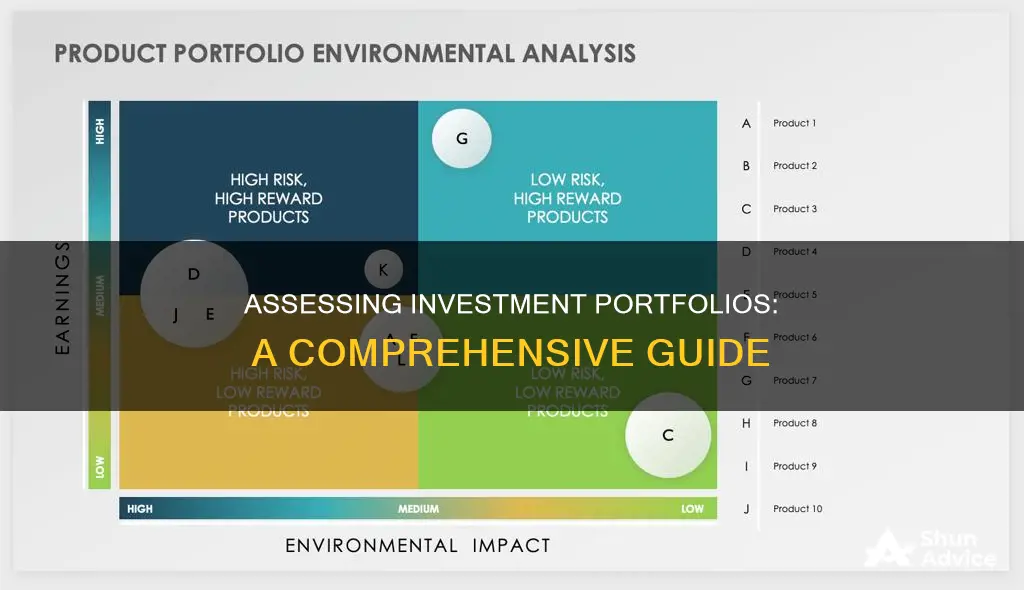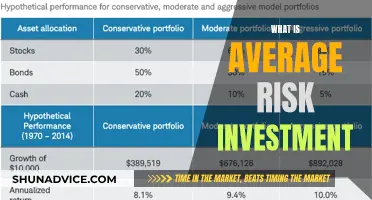
Analyzing an investment portfolio is a quantitative technique used to determine the specific characteristics of an investment portfolio. The process involves several stages, including a statistical performance review, risk and risk-adjusted metrics, attribution, and positioning. The goal is to help investors decide whether their portfolio has achieved its objectives and identify areas that can be optimized.
There are several key steps to analyzing an investment portfolio. Firstly, it is important to re-examine your investment goals and reconsider your risk profile. This includes assessing your risk tolerance and desired investment returns. Next, review your portfolio allocations and check your portfolio performance against benchmarks such as the S&P 500. Identify the fees and costs associated with holding your portfolio, as these can erode your returns over time. Finally, rebalance your portfolio if required to ensure it remains aligned with your current investment goals and risk appetite.
There are also various tools and ratios that can be used to analyze a portfolio, such as the Treynor, Sharpe, and Jensen ratios, which combine risk and return performance into a single value.
| Characteristics | Values |
|---|---|
| Performance Analysis | Assess how well a portfolio has performed over a specific period to help investors evaluate the success of their investments. |
| Risk Analysis | Analyse the risk in a portfolio to gauge the likelihood of future fluctuations or financial losses. |
| Risk-Return Analysis | Relate portfolio performance to the level of risk taken to understand how well returns compare to the inherent investment risk. |
| Portfolio Positioning | Describe how a portfolio's assets are spread across various asset classes, investment styles, company sizes, durations, credit quality, geographies, and factors. |
| Attribution Analysis | Assess the sources of portfolio returns by examining the impact of factors like asset allocation, security selection, and market movements. |
| Portfolio Composition | Consider factors such as the investment style and objectives, risk budget, and portfolio composition. |
| Portfolio Diversification | Diversify a portfolio to ensure it is aligned with the investor's risk-reward appetite. |
| Portfolio Rebalancing | Sell/buy and reallocate parts of a portfolio to better align with the investor's current investment goals. |
| Portfolio Fees and Costs | Evaluate the varied fees and costs associated with holding a portfolio, such as management fees, brokerage charges, and transaction and ongoing management charges. |
| Portfolio Benchmarking | Compare a portfolio's returns against an external benchmark, such as the S&P 500, to understand how the investments have performed. |
What You'll Learn

Performance analysis
Benchmarking
Comparing portfolio returns against relevant benchmarks is essential. This involves establishing measurable benchmarks that align with the portfolio's objectives and time horizon. For example, comparing returns against external indices such as the S&P 500 or the Nasdaq 100 index can help investors understand how their investments are performing relative to the broader market.
Risk-Adjusted Returns
Evaluating risk-adjusted returns is crucial to understanding the performance of a portfolio. While portfolio returns are important, they only tell part of the story. By incorporating risk into the analysis, investors can make more informed decisions. Tools such as the Treynor, Sharpe, and Jensen ratios combine risk and return into a single value, providing a comprehensive assessment of portfolio performance. These ratios consider factors such as volatility, market risk, and diversification to give a more nuanced understanding of the portfolio's performance.
Absolute and Relative Performance
Statistical Performance Review
Conducting a statistical performance review involves analyzing various metrics and ratios. This includes commonly used measures such as standard deviation, which indicates the volatility of the portfolio over a certain period. Additionally, metrics like the upside capture ratio, which measures the portfolio's performance relative to a benchmark index during rising markets, provide insights into how well the portfolio has performed in favourable market conditions.
Risk Analysis
Analyzing the risk associated with the portfolio is an integral part of performance analysis. By assessing the risk, investors can gauge the potential for future fluctuations or financial losses. This analysis should consider factors such as debt levels, portfolio drawdowns, and the overall volatility of the portfolio. Understanding the risk associated with the portfolio helps inform decision-making and determines whether adjustments are necessary to meet the investor's risk tolerance and objectives.
Savings vs Investment: Imbalance and its Impact
You may want to see also

Risk and risk-adjusted metrics
Risk analysis is a crucial aspect of portfolio analysis, helping investors gauge the likelihood of future fluctuations or financial losses. This analysis is relative to factors relevant to the portfolio, such as specific indices, peer groups, or custom benchmarks.
There are several methods for evaluating risk-adjusted performance, including:
- Alpha: This measures the excess return generated by an investment portfolio attributed to the portfolio manager's decisions. It is calculated as the portfolio's absolute return minus the benchmark return. A positive alpha means the portfolio manager has outperformed the benchmark.
- Sharpe Ratio: This compares a portfolio manager's returns in excess of the risk-free rate (e.g., US Treasury Bill yield) while factoring in the risk taken. It is calculated by subtracting the risk-free rate from the portfolio's total return and then dividing it by the standard deviation of the portfolio's excess return. A higher Sharpe ratio indicates better risk-adjusted performance.
- Treynor Ratio: This measures a portfolio manager's returns in excess of the risk-free rate, factoring in systematic risk. It is calculated the same way as the Sharpe ratio but uses beta (a measure of systematic risk) in the denominator. A higher Treynor ratio indicates better performance.
- Information Ratio: This measures the excess return on a portfolio over a predetermined benchmark relative to the variability of that excess return. It helps investors determine if the active manager outperforms the passive benchmark consistently. A higher information ratio is considered better.
- Standard Deviation: This is a statistical measure that quantifies the dispersion of data from its mean. In finance, it is used to gauge the historical volatility of an investment relative to its annual rate of return.
- Beta: This measures a security or sector's systematic risk relative to the entire stock market. It provides a quick way to assess an investment's volatility compared to a benchmark, typically the broader market. A beta of one indicates the same volatility as the market, while a beta greater or less than one indicates higher or lower volatility, respectively.
These risk-adjusted metrics provide investors with valuable tools to assess potential downsides and make data-driven decisions. They allow investors to better align their portfolios with their risk tolerance and financial goals, ensuring that the risk taken is worth the expected reward.
National Savings, Investment, and Their Symbiotic Relationship
You may want to see also

Attribution analysis
This analysis is useful for portfolio managers, investment firms, and investors. It can help them assess strategies and the performance of fund or money managers. It is a tool to explain and analyse a portfolio's performance, especially against a particular benchmark.
The analysis focuses on three key factors: the manager's investment picks and asset allocation, their investment style, and the market timing of their decisions and trades. The asset class and weighting of assets within a portfolio are considered in the analysis of investment choices. The nature of the holdings, such as low-risk or growth-oriented, is reflected in the investment style.
The process of attribution analysis begins by identifying the asset class in which a fund manager invests. This could be a broad category, such as fixed income or equities, and it can also specify a geographical marketplace or industry sector. Then, the allocation of different assets is analysed, looking at the percentage of the portfolio weighted towards specific segments, sectors, or industries.
Specifying the type of assets helps to establish a general benchmark for performance comparison. This benchmark is often a market index or a basket of comparable assets. Market indexes can be broad, like the S&P 500, or specific, such as focusing on real estate investment trusts.
The next step is to determine the manager's investment style, which will provide another benchmark for performance evaluation. The nature of the manager's holdings is analysed, such as large-cap or small-cap companies, or value- or growth-oriented.
Returns-based style analysis (RBSA) was introduced by William F. Sharpe in 1988. It charts a fund's returns and seeks an index with a similar performance history. Sharpe further refined this method with quadratic optimization, allowing for the assignment of a blend of indices that most closely correlate with a manager's returns. This blend forms a customised benchmark to evaluate the manager's performance and highlight excess returns, or alpha.
The final step in attribution analysis attempts to explain the alpha. It seeks to determine if the excess returns are due to the manager's stock picks, sector selections, or market timing. To attribute alpha to stock picks, an analyst must identify and subtract the portion of alpha attributable to sector and timing. This is done by developing customised benchmarks based on the manager's selected sectors and trade timing.
Market timing is the third significant factor in attribution analysis, though its importance is debated. It is challenging to quantify, and a significant portion of a manager's performance related to timing may be attributed to randomness or luck. Therefore, most analysts consider market timing less significant than asset selection and investment style.
A Safe Investment: Post Office Savings Schemes
You may want to see also

Portfolio positioning
Asset Allocation
Investment Styles
Investment styles refer to the approaches portfolio managers use to select and manage investments. Common styles include growth, value, or a blend of both. For instance, a portfolio may be positioned towards growth stocks, focusing on companies with expected high earnings growth rates. Alternatively, a value-oriented portfolio would seek undervalued securities trading below their intrinsic value.
Company Sizes (for Equities)
Durations (Sensitivity to Interest Rates)
The duration of a portfolio refers to its sensitivity to changes in interest rates. Portfolio positioning evaluates whether the portfolio is positioned towards longer-duration or shorter-duration investments. Longer-duration portfolios are more sensitive to interest rate changes and are often associated with fixed-income investments.
Credit Quality (for Fixed Income)
When analysing fixed-income investments, portfolio positioning assesses the credit quality of the issuers. This involves determining the proportion of investments in government securities, investment-grade corporate bonds, and high-yield or lower-rated securities. For example, a portfolio may be positioned towards high-quality, investment-grade bonds to minimise default risk.
Geographies
Geographical positioning examines the portfolio's exposure to different regions and countries. This involves evaluating whether the portfolio is focused on domestic investments or diversified across international markets. For instance, a portfolio may be positioned to take advantage of emerging market growth prospects by allocating a significant portion to equities in those regions.
Factors
Factor investing involves selecting securities based on specific characteristics believed to drive returns. Portfolio positioning considers factors such as style, yield, momentum, quality, volatility, liquidity, and size. For example, a portfolio may be positioned towards high-dividend-yielding stocks, prioritising income generation for investors.
In summary, portfolio positioning is a comprehensive evaluation of how a portfolio's assets are distributed across various dimensions. It provides insights into the portfolio manager's strategies, risk tolerance, and expected returns. By understanding portfolio positioning, investors can assess whether the portfolio aligns with their investment objectives and make informed decisions about optimising their investments.
Solow Model: Investment Savings Strategy for Long-Term Growth
You may want to see also

Asset allocation
Stocks
Stocks, or equities, have the potential for high returns but also carry high risk. This is known as "equity exposure". The value of stocks fluctuates, and there is a chance they could become worthless. However, they are necessary for substantial growth over time.
Stocks can be further divided into subclasses:
- Large-cap stocks: Shares issued by companies with a market capitalization above $10 billion.
- Mid-cap stocks: Shares issued by companies with a market capitalization between $2 billion and $10 billion.
- Small-cap stocks: Shares issued by companies with a market capitalization of less than $2 billion. These tend to have higher risk due to lower liquidity.
- International securities: Securities issued by foreign companies and listed on a foreign exchange.
- Emerging markets: Securities issued by companies in developing nations. These have high potential returns but also high risk due to country risk and lower liquidity.
Bonds
Bonds are part of the fixed-income security family and are a more stable option when stocks are performing poorly. They are issued by companies and governments to raise money. US Treasury bonds are considered a safe investment as they are backed by the government and have very low default risk. Bonds pay a set amount of interest, either periodically or at maturity, and return the principal at the end of the period.
Cash
Cash provides liquidity to a portfolio, allowing quick access to funds. This can include high-yield savings accounts or short-term bonds. While cash provides flexibility and buffers against equity risk, it is unlikely to beat inflation over time.
Other Assets
Other assets that can be included in a portfolio are:
- Money market securities: Investments in short-term debt, usually a year or less. Treasury bills are the most common example.
- Real estate investment trusts (REITs): Shares in a pool of mortgages or properties.
Model Portfolios
Investment companies often create model portfolios with different proportions of asset classes, ranging from conservative to very aggressive. These serve as guidelines and can be modified to suit an individual's needs.
Conservative portfolios allocate a large percentage to lower-risk securities such as fixed-income and money market securities, with the main goal of protecting the principal value.
Moderately conservative portfolios aim to preserve most of the portfolio's value but are willing to take on some risk. A common strategy is choosing securities that pay high dividends or coupon payments.
Moderately aggressive portfolios are often called balanced portfolios, with almost equal divisions between fixed-income securities and equities. This strategy suits investors with a longer time horizon and a medium level of risk tolerance.
Aggressive portfolios mainly consist of equities, providing the potential for long-term capital growth but with wide value fluctuations.
Very aggressive portfolios consist almost entirely of stocks, targeting strong capital growth over a long time horizon. These portfolios carry considerable risk and will vary widely in the short term.
Factors to Consider
When deciding on asset allocation, it is important to consider your risk tolerance, investment objectives, time horizon, and available funds. Your asset allocation should be regularly reviewed and adjusted to align with your changing financial needs and goals.
A popular rule of thumb is the "100 minus age" rule, which suggests investing a percentage of your portfolio in stocks equal to 100 minus your age, with the remainder in bonds and safer assets. For example, a 30-year-old might invest 70% in stocks and 30% in bonds.
It is also important to rebalance your portfolio periodically, especially after major life changes or when your asset allocation has drifted from its target. This ensures your portfolio remains aligned with your goals and risk tolerance.
Savings and Investments: Two Sides of the Same Coin
You may want to see also







